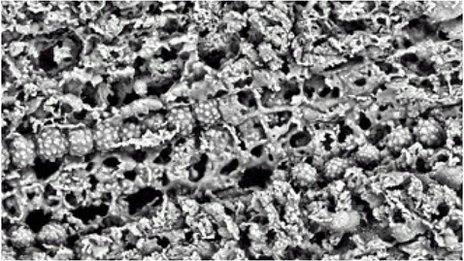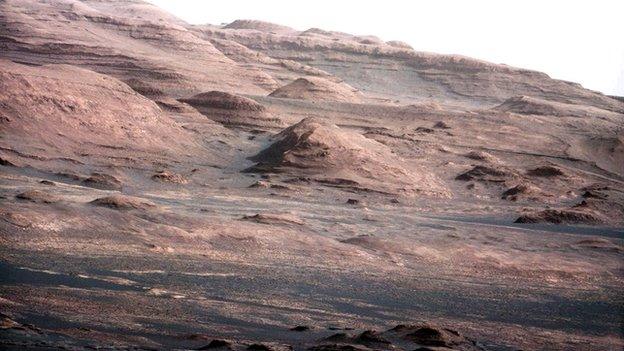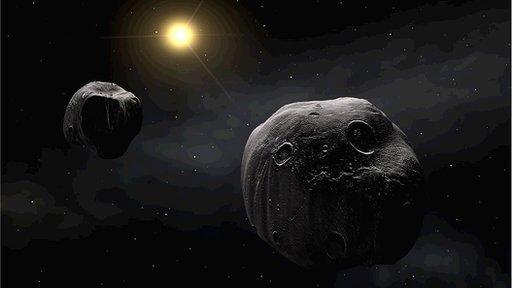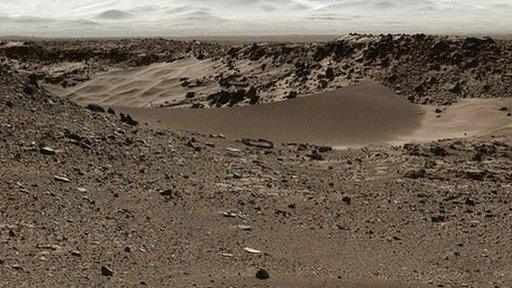Ancient plants 'frozen in time' by space impacts
- Published
These electron microscope images show the preserved fragments of plants from Argentina.
Ancient plant material has been preserved in the glass formed by asteroids hitting the Earth, scientists report.
The "frozen in aspic" appearance of what are apparently fragments of grass is spectacular enough.
But a team writing in Geology journal, external says that delicate organic chemicals have also been conserved inside.
Incredibly, the searing heat generated by the impacts was responsible for the remarkable preservation.
The findings could even point to a new way of searching for past life on Mars.
The impact glasses examined in this study come from the Pampas of Argentina and have a range of dates under 10 million years old - in the Miocene and Holocene periods.
When objects from space slam into the ground they melt the target rocks. Hot material gets thrown out of the craters and, in these cases, it captures and traps shards of vegetation.
Scientists say the plant remains look very similar to the Pampas grass that still grows in the region today.
Prof Peter Schultz, from Brown University in Rhode Island, US, presented the work at last month's Lunar and Planetary Science Conference (LPSC), external in The Woodlands, Texas.
In their scientific paper, the Brown University geologist, R Scott Harris, Marcelo Zarate and others write that while space collisions can destroy life on local or global scales, "it can also preserve components of the local biology present at the time of impact".
Prof Schultz told BBC News: "It turns out the composition of the plant material is very similar to the composition of the impact glass itself.
"It was very rapidly transferred from one thing to the other, likely due to the rapid and high heat that boiled off that plant material and replaced it with glass," Prof Schultz explained.
Loess and found
The impact glass is found distributed among the sedimentary layers of loess, a rock type formed through the accumulation of wind-blown dust.
Impacts into this type of sediment generate impact melt more readily and preserve it more readily. The scientists have reported evidence for seven separate space impacts over a period of several million years, in an area of Argentina no bigger than Texas.
Prof Schultz said there was some debate about whether this number of impacts was unusual. "If you look at theoretical models, it's about a factor of three too high. But I think that may be because it's a theoretical model," he explained.

This microscope image shows structures have been preserved at the cellular scale
The Pampas region retains a record of loess for the last 12 million years. While this type of sediment exists in North America, examples date to the last Ice Age, some 18,000 years ago or later.
Prof Schultz said: "In North America, the slate was wiped clean. The glaciers eroded them, so we only see a fraction of the real evidence. But in South America it's all preserved, so the impacts send out these glassy globs that get trapped... because stuff keeps coming in on top."
The researchers carried out heating experiments in an effort to recreate this type of capture and preservation in the laboratory. They used samples of grass from the Argentinean pampas, mixed them with pulverised impact glass and flash heated them in a furnace at a range of temperatures for 10, 60 & 300 seconds.
The results revealed that temperature was the critical factor determining whether the grass was burned to a crisp, or preserved.
When temperatures in the furnace were kept below 1,500C, the grass invariably carbonised. It was when the temperature was raised above 1,500C that the broad-scale features of the leaves were conserved and samples began to resemble the natural ones from Argentina.
"It is counter-intuitive," said Prof Schultz, adding that bubbling on the edges of the plant material as water turned into steam provided an insulating layer to protect the interior.
Martian opportunity
Simon Clemett and Kathie Thomas-Keprta from Nasa's Johnson Space Center in Houston analysed the delicate and complex organic compounds recovered from the glass. They include polycyclic aromatic hydrocarbons and other molecules found in biological material.
Metal oxides found in the samples are thought to be the result of bacteria acting on decaying plants.
"I was surprised to find the amount of plant matter preserved," Dr Thomas-Keprta told BBC News, "Next we need to evaluate if microbes can also be preserved by this mechanism. Then, we need to collect the appropriate samples on Mars."
Pete Schultz believes it's entirely possible that genetic material might also be preserved, though he says RNA - a relatively robust molecule that fulfils several vital roles such as in the expression of genes - stands a greater chance of surviving than more fragile DNA.
"It's still a big question… but if you look at what has been preserved, these are some pretty sensitive chemicals," he said.

Impact glasses might be found all over Mars, including in Gale Crater
The discovery could offer a novel approach to searching for signs of past life on the Red Planet.
"Mars has the same type of material [loess] spread all over the place, and Gale Crater is one very good example," said Pete Schultz. It is to Gale that Nasa has sent its latest robotic rover Curiosity.
"The stuff in the centre of the crater that's piled up is very likely the result of dust accumulation."
He said the rover could look for impact glass in rocks that had tumbled out naturally from these geological layers.
There were probably 20 impacts in the last four billion years of Martian history comparable in size to the Chicxulub impact - the collision on Earth 66 million years ago that killed off the dinosaurs. Prof Schultz thinks this would have spread impact glass right around the Red Planet.
On Mars, he pointed out, researchers would be looking not for evidence of plant material in impact glass, but for "something very primitive", such as accumulations of microbial life.
Follow Paul on Twitter, external.
- Published18 March 2014

- Published4 February 2014
